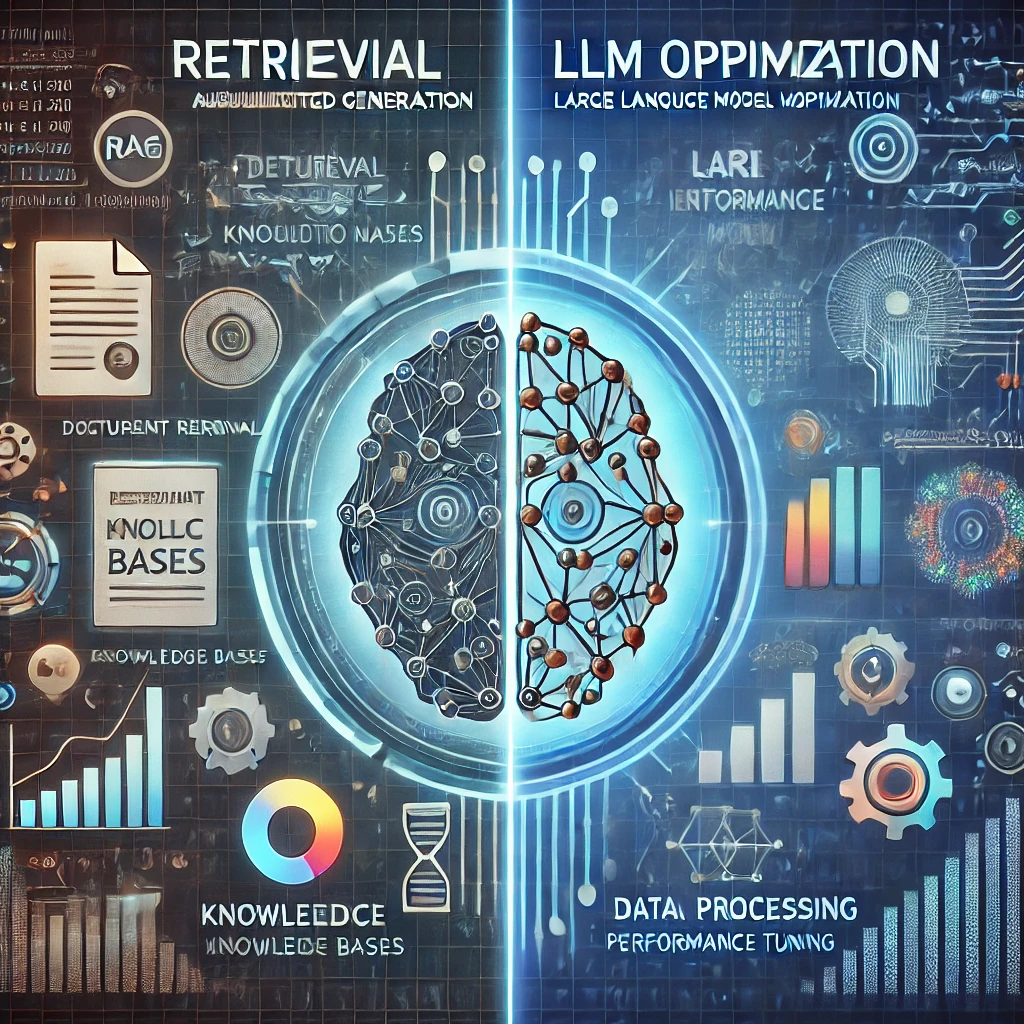The intersection of Retrieval-Augmented Generation (RAG) and Large Language Models (LLMs) offers significant advancements in natural language processing (NLP). Both approaches have been optimized for various applications, but each comes with unique capabilities and challenges. This article delves into both methods, provides a comparison, and gives tips to avoid common issues such as hallucinations.
What is Retrieval-Augmented Generation (RAG)?
RAG is a hybrid model that combines two key processes: retrieval and generation. In a typical RAG setup, a retrieval module fetches relevant documents or data from external sources like a knowledge base. This retrieved information is then passed to a generation module (usually an LLM) to create coherent responses or perform tasks such as summarization or question answering.
Advantages of RAG:
- Improved Accuracy: By sourcing factual data during the retrieval phase, RAG reduces the chances of generating incorrect or “hallucinated” information.
- Better Scalability: Since the retrieval component handles large databases, RAG scales well for knowledge-intensive tasks without burdening the generation component with all the information.
- Domain-Specific Use Cases: RAG can be customized to retrieve from specialized knowledge bases, making it ideal for industries like healthcare or chemical analysis.
What is LLM Optimization?
LLM optimization focuses on enhancing the efficiency, accuracy, and reliability of Large Language Models. Techniques for optimizing LLMs include model fine-tuning, prompt engineering, and efficient computation methods like quantization or pruning.
Key optimization methods:
- Fine-tuning: Adapting a pre-trained model on a smaller, domain-specific dataset to improve performance on specific tasks.
- Prompt engineering: Structuring prompts or queries in ways that guide the model towards accurate and contextually appropriate responses.
- Quantization and Pruning: Reducing the size of the model while maintaining performance by removing unnecessary parameters or reducing the precision of calculations.
While LLMs excel at generating human-like text and handling open-domain tasks, they can sometimes struggle with accuracy when specific facts or domain knowledge is required. This is where RAG can be more advantageous.
RAG vs. LLM Optimization
| Feature | RAG | LLM Optimization |
|---|---|---|
| Core Functionality | Combines retrieval and generation | Enhances efficiency and accuracy of LLMs |
| Data Source | Retrieves factual data from external sources | Utilizes the internal knowledge of the model |
| Accuracy | Higher accuracy due to retrieval of real-time data | Can suffer from hallucinations if not well-optimized |
| Scalability | Scales with large, dynamic datasets | Scales with hardware optimizations |
| Use Case Flexibility | Ideal for knowledge-intensive tasks | Better for creative, open-ended tasks |
Tips to Avoid Hallucinations
Hallucinations occur when an LLM generates information that seems plausible but is factually incorrect. This issue is particularly important in high-stakes domains like healthcare or legal analysis. Here are some tips to minimize hallucinations:
- Use RAG for factual responses: When working with fact-heavy tasks, consider using a RAG model to ensure the generation component has access to real-world data.
- Fine-tune your model: Fine-tuning your LLM on domain-specific datasets can improve accuracy, especially if the model is expected to perform specialized tasks.
- Implement confidence thresholds: Set thresholds for model outputs. If the model’s confidence score is too low, use alternative methods such as retrieval or simply flag the response as uncertain.
- Test prompts rigorously: Use prompt engineering to test various phrasings and scenarios. Ensure that your prompts elicit responses that align with factual and ethical standards.
- Incorporate post-processing checks: Run generated responses through post-processing logic or even human verification, especially for critical applications.
Code Example: Implementing RAG for a Question-Answering Task
Here’s an example of a simple RAG implementation using Python’s Hugging Face library:
from transformers import RagRetriever, RagTokenForGeneration, RagTokenizer
# Load pre-trained RAG model
tokenizer = RagTokenizer.from_pretrained("facebook/rag-token-base")
retriever = RagRetriever.from_pretrained("facebook/rag-token-base")
model = RagTokenForGeneration.from_pretrained("facebook/rag-token-base", retriever=retriever)
# Define question and context
question = "What is the capital of the Philippines?"
input_ids = tokenizer(question, return_tensors="pt").input_ids
# Perform retrieval and generation
generated = model.generate(input_ids)
output = tokenizer.batch_decode(generated, skip_special_tokens=True)
print(f"Answer: {output}")In this example, the RAG model retrieves relevant documents to improve the quality of the generated answer.
Code Example: Fine-tuning an LLM
Here’s a code snippet showing how to fine-tune a pre-trained GPT-2 model on a custom dataset:
from transformers import GPT2LMHeadModel, GPT2Tokenizer, Trainer, TrainingArguments
from datasets import load_dataset
# Load GPT-2 and tokenizer
model = GPT2LMHeadModel.from_pretrained("gpt2")
tokenizer = GPT2Tokenizer.from_pretrained("gpt2")
# Load custom dataset
dataset = load_dataset('path_to_dataset')
# Tokenize dataset
def tokenize_function(examples):
return tokenizer(examples['text'], truncation=True, padding='max_length')
tokenized_dataset = dataset.map(tokenize_function, batched=True)
# Set training arguments
training_args = TrainingArguments(
output_dir="./gpt2-finetuned",
evaluation_strategy="epoch",
learning_rate=2e-5,
per_device_train_batch_size=8,
per_device_eval_batch_size=8,
num_train_epochs=3
)
# Create trainer
trainer = Trainer(
model=model,
args=training_args,
train_dataset=tokenized_dataset['train'],
eval_dataset=tokenized_dataset['test']
)
# Fine-tune the model
trainer.train()This fine-tuning process helps align GPT-2 with the desired domain-specific knowledge.
Conclusion
RAG and LLM optimization each have their strengths, and choosing the right approach depends on your task. For factual or knowledge-intensive tasks, RAG provides accuracy by pulling data from reliable sources. On the other hand, optimizing LLMs offers flexibility and creativity for open-ended tasks. Minimizing hallucinations through careful prompt engineering, fine-tuning, and retrieval methods is key to ensuring reliable outputs.
By employing both RAG and LLM optimization strategies effectively, you can build powerful AI systems that deliver accurate, reliable, and contextually relevant outputs.
“I, Evert-Jan Wagenaar, resident of the Philippines, have a warm heart for the country. The same applies to Artificial Intelligence (AI). I have extensive knowledge and the necessary skills to make the combination a great success. I offer myself as an external advisor to the government of the Philippines. Please contact me using the Contact form or email me directly at evert.wagenaar@gmail.com!”
[SEO optimized]

Wow very nice
Thank you!